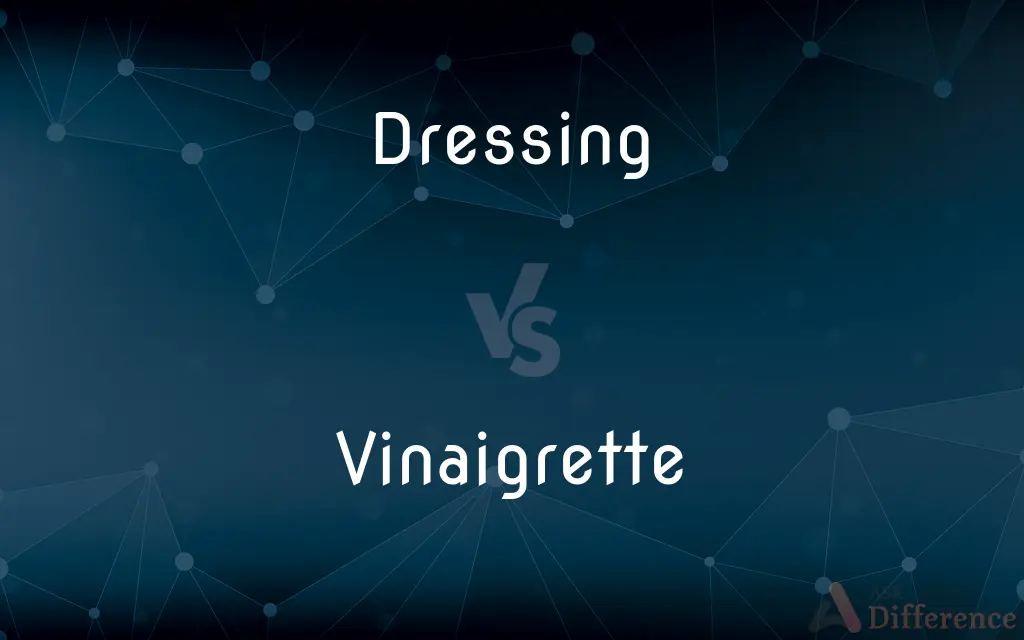Dressing vs. Vinaigrette — What's the Difference?
By Fiza Rafique & Maham Liaqat — Updated on March 14, 2024
Dressing is a general term for sauces used on salads, while vinaigrette is a specific type of dressing made with oil and vinegar.

Difference Between Dressing and Vinaigrette
Table of Contents
ADVERTISEMENT
Key Differences
Dressing encompasses a wide variety of sauces used to enhance salads, including creamy, mayonnaise-based options, and lighter, oil-based types. Vinaigrette, on the other hand, is a specific kind of dressing that traditionally consists of a mixture of oil and vinegar, often flavored with herbs, spices, and other seasonings.
While dressings can range from thick and creamy to light and fluid, vinaigrettes are characteristically light and liquidy, with a distinctive oil and vinegar separation that requires shaking before use.
Dressings often include a broad spectrum of ingredients like dairy products, mayonnaise, herbs, spices, and even fruits to create various flavors and textures. In contrast, vinaigrettes rely primarily on the quality and ratio of oil to vinegar, with additional ingredients serving to complement rather than dominate the flavor profile.
The choice between dressing and vinaigrette can significantly influence the character of a salad, with dressings offering a richer, often more decadent experience, and vinaigrettes providing a lighter, more refreshing taste that highlights the natural flavors of the salad ingredients.
Despite their differences, both dressings and vinaigrettes serve the essential function of adding moisture, flavor, and complexity to salads, making them integral components of the culinary world.
ADVERTISEMENT
Comparison Chart
Base Ingredients
Can include dairy, mayonnaise, oil, or yogurt
Primarily oil and vinegar
Texture
Ranges from creamy to light
Generally light and fluid
Flavor Profile
Can be varied, from tangy and sweet to creamy
Typically tangy, with a balance of oil and acid
Usage
Used on salads, sandwiches, and dips
Mainly used on salads
Key Components
May contain herbs, spices, and various flavorings
Often includes herbs, spices, and sometimes mustard for emulsification
Compare with Definitions
Dressing
A sauce used to add flavor and moisture to salads, ranging from creamy to light.
The chef prepared a creamy Caesar dressing for the salad.
Vinaigrette
A light dressing made primarily from oil and vinegar.
She dressed the green salad with a simple balsamic vinaigrette.
Dressing
Can include dairy products, oils, vinegars, herbs, and spices.
The dressing featured a blend of yogurt, dill, and cucumber.
Vinaigrette
Characterized by its fluidity and the need to be shaken before use.
The vinaigrette separated into layers of oil and vinegar on standing.
Dressing
Includes a wide range of flavors and textures.
For the barbecue, we made both a ranch and a blue cheese dressing.
Vinaigrette
Known for its tangy taste, balancing the richness of oil with the sharpness of vinegar.
The raspberry vinaigrette added a refreshing acidity to the summer salad.
Dressing
Used on salads, but also as dips and sandwich spreads.
The tangy dressing doubled as a delicious dip for the vegetable platter.
Vinaigrette
Primarily used on salads to enhance natural flavors without overwhelming them.
A light vinaigrette was chosen to not overpower the delicate flavors of the mixed greens.
Dressing
Often richer and can be tailored to a wide range of dietary preferences.
The vegan dressing used avocado and lime for a creamy texture.
Vinaigrette
Often includes an emulsifier like mustard to help blend the oil and vinegar.
The mustard in the vinaigrette helped to maintain a smooth consistency.
Dressing
A sauce for salads, typically one consisting of oil and vinegar with herbs or other flavourings
Sprinkle each salad lightly with dressing
Vinaigrette dressing
Vinaigrette
Vinaigrette ( vin-ə-GRET) is made by mixing an oil with something acidic such as vinegar or lemon juice. The mixture can be enhanced with salt, herbs and/or spices.
Dressing
A piece of material used to cover and protect a wound
An antiseptic dressing
Vinaigrette
A cold sauce or dressing made of vinegar or lemon juice and oil, often flavored with finely chopped onions, herbs, and other seasonings.
Dressing
Size or stiffening used in the finishing of fabrics
Fabrics finished with dressing will work successfully when cut an inch wide
Vinaigrette
A small decorative bottle or container with a perforated top, used for holding an aromatic preparation such as smelling salts.
Dressing
A therapeutic or protective material applied to a wound.
Vinaigrette
A sauce, made of an acidic liquid such as vinegar or lemon juice; oil; and other ingredients, used as a salad dressing, or as a marinade for cold meats.
Dressing
A sauce for certain dishes, such as salads.
Vinaigrette
(obsolete) A small perforated box for holding aromatic vinegar contained in a sponge, or a smelling bottle for smelling salts; called also vinegarette.
Dressing
A stuffing, as for poultry or fish.
Vinaigrette
(obsolete) A small, two-wheeled vehicle, like a Bath chair, to be drawn or pushed by a person.
Dressing
Manure or other fertilizing material for soil.
Vinaigrette
A sort of Russian salad, originally using French salad dressing.
Dressing
(medicine) Material applied to a wound for protection or therapy.
Vinaigrette
A sauce, made of vinegar, oil, and other ingredients, - used esp. for cold meats.
Dressing
(cooking) A sauce, especially a cold one for salads.
Vinaigrette
A small perforated box for holding aromatic vinegar contained in a sponge, or a smelling bottle for smelling salts; - called also vinegarette.
Dressing
Something added to the soil as a fertilizer etc.
Vinaigrette
A small, two-wheeled vehicle, like a Bath chair, to be drawn or pushed by a boy or man.
Dressing
The activity of getting dressed.
Vinaigrette
Oil and vinegar with mustard and garlic
Dressing
(obsolete) Dress; raiment; especially, ornamental habiliment or attire.
Dressing
The stuffing of fowls, pigs, etc.
Dressing
Gum, starch, etc., used in stiffening or finishing silk, linen, and other fabrics.
Dressing
An ornamental finish, such as a moulding around doors, windows, or on a ceiling.
Dressing
(dated) Castigation; scolding; a dressing down.
Dressing
(dated) The process of extracting metals or other valuable components from minerals.
Dressing
Present participle of dress
Dressing
Dress; raiment; especially, ornamental habiliment or attire.
Dressing
An application (a remedy, bandage, etc.) to cover a sore or wound.
Dressing
Manure or compost over land. When it remains on the surface, it is called a top-dressing.
Dressing
A preparation, such as a sauce, to flavor food for eating; a condiment; as, a dressing for salad.
Dressing
Gum, starch, and the like, used in stiffening or finishing silk, linen, and other fabrics.
Dressing
An ornamental finish, as a molding around doors, windows, or on a ceiling, etc.
Dressing
Castigation; scolding; - often with down.
Dressing
Savory dressings for salads; basically of two kinds: either the thin French or vinaigrette type or the creamy mayonnaise type
Dressing
A mixture of seasoned ingredients used to stuff meats and vegetables
Dressing
Making fertile as by applying fertilizer or manure
Dressing
A cloth covering for a wound or sore
Dressing
Processes in the conversion of rough hides into leather
Dressing
The activity of getting dressed; putting on clothes
Dressing
The act of applying a bandage
Common Curiosities
How should vinaigrette be stored?
Vinaigrette should be stored in a sealed container in the refrigerator and shaken well before use to recombine the ingredients.
Can dressing be used for cooking?
Yes, some dressings can be used in cooking, as marinades for meat or flavor enhancers in cooked dishes.
Is a vinaigrette healthier than other dressings?
Vinaigrettes can be healthier due to their oil and vinegar base, which is lighter than cream or mayonnaise-based dressings, but it depends on the specific ingredients used.
Can any sauce be considered a dressing?
Generally, dressings are sauces specifically intended for salads, sandwiches, or dips, so not all sauces qualify as dressings.
What makes a dressing creamy?
Ingredients like mayonnaise, yogurt, sour cream, or avocado can give a dressing a creamy texture.
How long can homemade dressing last?
The shelf life of homemade dressing varies based on ingredients, but it generally lasts about 1-2 weeks when stored properly in the refrigerator.
Are dressings suitable for all types of salads?
The suitability of a dressing depends on the salad's ingredients; heavier dressings pair well with robust salads, while lighter salads benefit from a vinaigrette.
Do all vinaigrettes contain mustard?
Not all vinaigrettes contain mustard, but it is a common emulsifier used to help blend and stabilize the mixture.
How can I thicken a vinaigrette?
Adding an emulsifier like mustard or blending the vinaigrette with ingredients like garlic or shallots can help thicken it.
Why does vinaigrette separate?
Vinaigrette separates due to the differing densities and polarities of oil and vinegar, which don't naturally mix without an emulsifier.
Can I make vinaigrette without vinegar?
Traditional vinaigrette requires vinegar, but you can experiment with other acids like lemon or lime juice for a similar effect.
How do I choose the right dressing for my salad?
Consider the salad's ingredients and desired flavor profile; lighter, delicate greens pair well with vinaigrettes, while heartier salads can handle richer, creamy dressings.
Can vinaigrette be used as a marinade?
Yes, vinaigrette can double as a marinade for meats or vegetables, adding flavor and acidity to tenderize.
Are there dairy-free dressing options?
Many dressings, especially vinaigrettes, are naturally dairy-free, and there are also numerous recipes for dairy-free creamy dressings using alternative ingredients.
Can I freeze dressing?
Freezing dressing is not recommended as it can separate and change texture upon thawing, especially if it's creamy or mayonnaise-based.
Share Your Discovery

Previous Comparison
Aeriated vs. Aerated
Next Comparison
Appropriate vs. ProperAuthor Spotlight
Written by
Fiza RafiqueFiza Rafique is a skilled content writer at AskDifference.com, where she meticulously refines and enhances written pieces. Drawing from her vast editorial expertise, Fiza ensures clarity, accuracy, and precision in every article. Passionate about language, she continually seeks to elevate the quality of content for readers worldwide.
Co-written by
Maham Liaqat














































